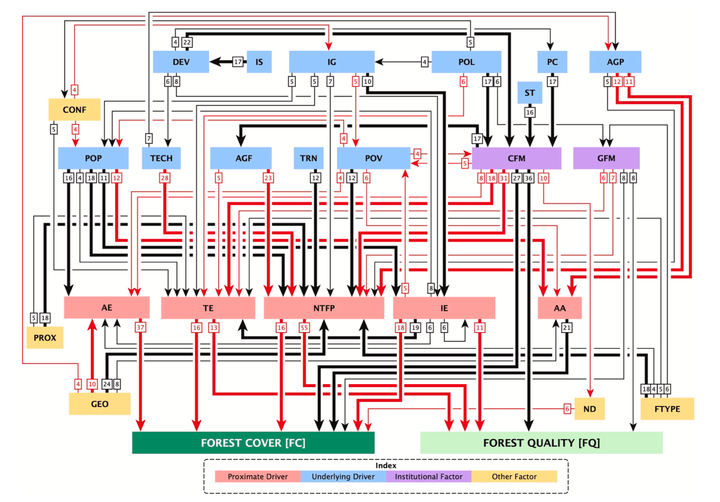Drivers and mechanisms of forest change in the Himalayas
 Causal network diagram showing the relationships between proximate and underlying drivers, institutional factors, and other factors of forest change in the Himalayas. The arrows indicate the direction of influence, from driver to effect and the boxed number indicates the frequency of occurrence of the relationship in the case studies. The colour of the arrows indicates whether the effect is directly associated (black) or inversely associated (red). Relationships occurring in four or more case studies are represented here. Thicker lines represent most prevalent relationships (10 or more case studies). Definitions of acronyms are given in Table 2. (For interpretation of the references to colour in this figure legend, the reader is referred to the web version of this article.)
Causal network diagram showing the relationships between proximate and underlying drivers, institutional factors, and other factors of forest change in the Himalayas. The arrows indicate the direction of influence, from driver to effect and the boxed number indicates the frequency of occurrence of the relationship in the case studies. The colour of the arrows indicates whether the effect is directly associated (black) or inversely associated (red). Relationships occurring in four or more case studies are represented here. Thicker lines represent most prevalent relationships (10 or more case studies). Definitions of acronyms are given in Table 2. (For interpretation of the references to colour in this figure legend, the reader is referred to the web version of this article.)
Abstract
Mountains are critical ecosystems that have a strong influence far beyond their topographic boundaries. More than 50 million people inhabit the Himalayas, and more than one billion people depend on the ecosystem services they provide. Anthropogenic activities have driven concurrent deforestation and regeneration in the Himalayas, and interventions to reduce forest loss and promote forest recovery require a synthetic understanding of the complex and interacting drivers of forest change. We conducted a systematic review of case studies from 1984 to 2020 (n=137) and combined a system dynamics approach with a causal network analysis to identify, map and articulate the relationships between the drivers, actors and mechanisms of forest change across the entirety of the Himalayan mountain range. In total, the analysis revealed five proximate drivers, 12 underlying drivers, two institutional factors and five ‘other’ factors connected by a total of 221 linkages. Forest change dynamics have been dominated by widespread smallholder agriculture, extensive non-timber forest product extraction, widespread commercial and non-commercial timber extraction, and high rates of agricultural abandonment. Underlying drivers include population growth, poor agricultural productivity, international support for development projects, and successful community forest management systems. Contradictory linkages emerge from a combination of contextual factors, which can have negative impacts on conservation goals. Global processes such as shifts in governance, transnational infrastructure-development programs, economic slowdowns, labor migrations and climate change threaten to destabilize established dynamics and change forest trajectories. The underlying and proximate drivers interact through multiple pathways that can be utilized to achieve conservation goals. Based on this analysis, we highlight five thematic focus areas to curtail forest loss and promote recovery–(1) decreasing the population pressure, (2) sustainable increase of agricultural productivity, (3) strengthening of forest management institutions, (4) leveraging tourism growth and sustainable infrastructure expansion, and (5) fuel transition and establishing firewood plantations on degraded land. The broader adoption of systems thinking, and specifically a system dynamics approach and causal network analysis, will greatly enhance the rigour of policy development, help design site-specific interventions at multiple spatial scales which can respond to local and global changes, and guide deeper inquiry to enhance our understanding of driver-forest dynamics.